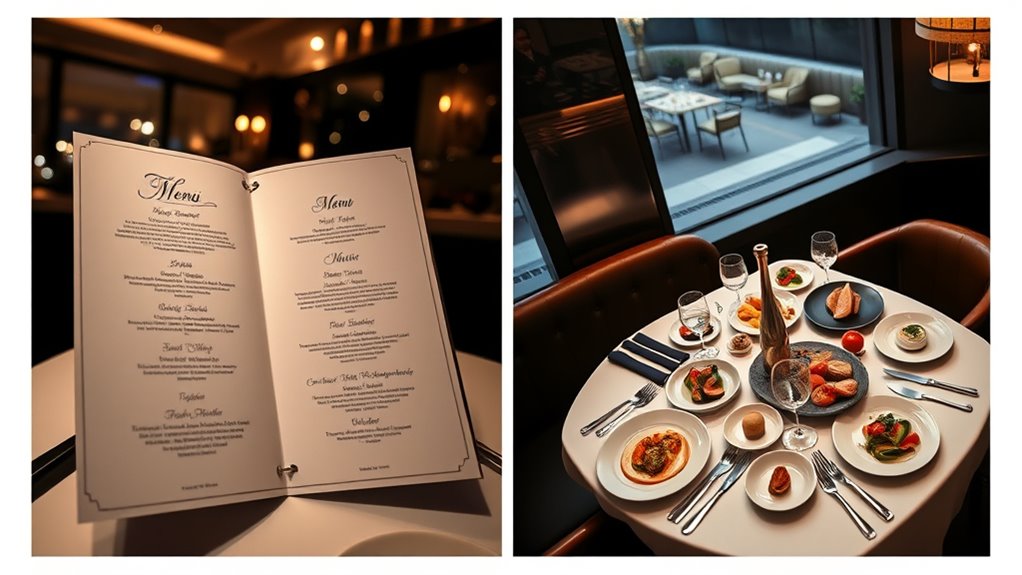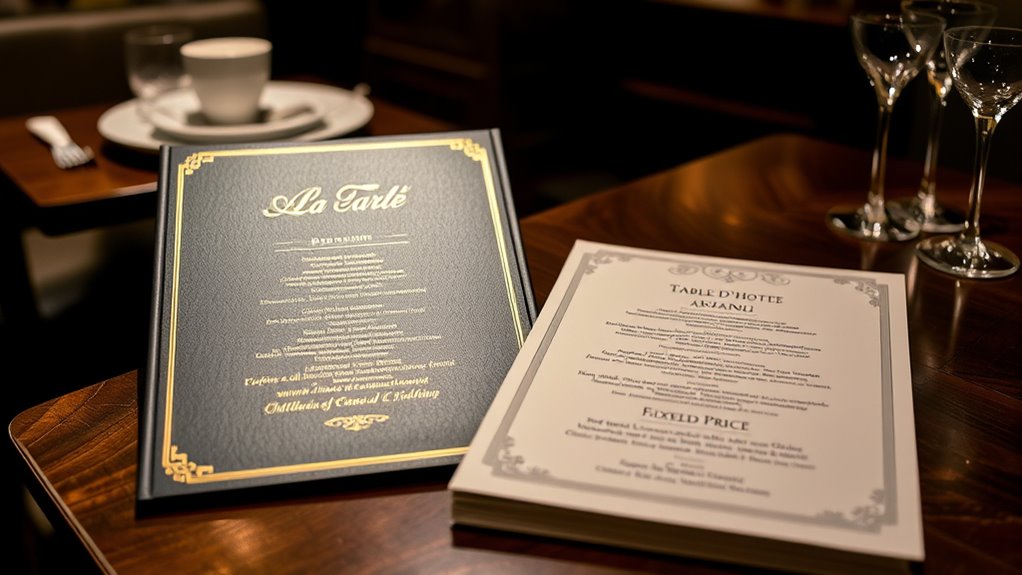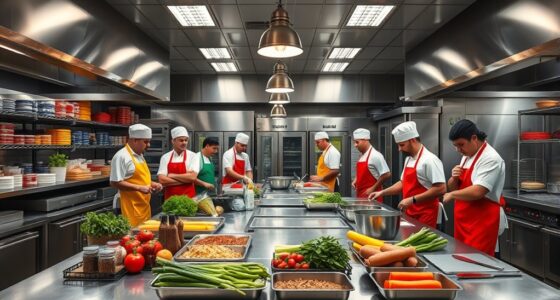Choosing between À La Carte and Table D’Hôte menus depends on your preferences. With À La Carte, you select individual dishes, customize your meal, and control costs, perfect if you want variety and flexibility. In contrast, Table D’Hôte offers fixed menus at set prices, which suit those seeking a straightforward dining experience or special occasions. Understanding these differences can help you make better choices, and you’ll discover more insights as you explore further.
Key Takeaways
- À La Carte offers individual dish choices with flexible pricing, while Table D’Hôte provides a fixed multi-course meal at a set price.
- À La Carte emphasizes customization and variety, whereas Table D’Hôte features limited options with a predetermined menu.
- À La Carte is suitable for diners seeking control over meal composition and expenses; Table D’Hôte is ideal for straightforward or curated dining experiences.
- Pricing in À La Carte depends on selected dishes, potentially increasing costs; Table D’Hôte offers predictable, often more economical, fixed pricing.
- The ambiance varies: À La Carte often suits diverse settings with flexible service; Table D’Hôte favors formal or themed environments for consistency.

Have you ever wondered what different menu types mean and how they impact your dining experience? When you walk into a restaurant, the way the menu is structured can considerably influence your options, pricing flexibility, and overall satisfaction. Two common types are À La Carte and Table D’Hôte menus, and understanding their differences helps you make better choices.
With an À La Carte menu, you get to pick individual dishes from a broad selection, each with its own price. This setup offers you maximum customer choices, allowing you to customize your meal exactly how you want it. If you’re craving a specific appetizer, main course, and dessert, an À La Carte menu lets you craft a meal tailored to your preferences. This flexibility often means you can control the overall cost more precisely, since you’re only paying for what you select. It’s ideal if you enjoy variety and want to explore different dishes or if you have dietary restrictions that require specific options.
Choose individual dishes and customize your meal with an À La Carte menu for maximum flexibility and control.
On the other hand, a Table D’Hôte menu presents a fixed set of courses at a predetermined price. This format usually includes a few options for each course, but the overall structure remains consistent. Because of this, it tends to offer less pricing flexibility—you pay one price for the entire meal, regardless of your specific choices within the set menu. However, this can be advantageous if you’re looking for a straightforward dining experience or want to try a complete meal without the stress of choosing each component. The fixed nature of a Table D’Hôte menu often results in a more economical option, especially in fine dining establishments where it simplifies service and streamlines kitchen operations.
Additionally, natural materials are often used in farmhouse decor to create a warm, rustic ambiance that enhances the dining experience. Your decision between these menu types depends on what you value most. If having diverse customer choices and flexible pricing is your priority, an À La Carte menu is probably more appealing. It allows you to tailor your meal and spend only on what you desire. Conversely, if you prefer a set meal with predictable costs and a curated experience, the Table D’Hôte menu might suit you better. It’s particularly popular in special occasions or when a restaurant wants to showcase a specific culinary theme or chef’s selection.
Ultimately, understanding these menu types helps you navigate your options more confidently. Whether you prefer the freedom of À La Carte or the simplicity of a Table D’Hôte, knowing how they differ ensures you get the most out of your dining experience.
Frequently Asked Questions
How Do Pricing Differences Impact Customer Choices?
Pricing strategies markedly influence your choices, as À La Carte menus usually offer more flexibility and higher prices, appealing to customers seeking customization. In contrast, Table D’Hôte menus tend to have fixed prices, attracting budget-conscious diners or those preferring set meals. Your preferences for variety versus affordability shape your decision, with pricing differences guiding you toward options that best match your taste and budget.
Which Menu Style Is More Flexible for Dietary Restrictions?
Think of the menu as a chameleon—more adaptable and changeable. An à la carte menu offers greater flexibility, allowing you to select customization options tailored to your dietary restrictions. You can mix and match dishes, making it easier to find suitable dietary accommodations. This style gives you control over your meal, ensuring your needs are met without feeling limited, unlike the fixed options often found on a Table d’Hôte menu.
Can a Restaurant Combine Both Menu Types?
Yes, a restaurant can combine both menu types to offer better menu customization and ingredient flexibility. By doing so, you get the benefits of à la carte’s versatility and the structured options of a table d’hôte. This approach allows you to cater to various dietary restrictions, giving you more control over ingredient choices while still presenting set menus for efficiency. It’s a smart way to satisfy diverse customer preferences.
How Do Service Times Vary Between Menu Types?
Service times differ markedly between menu types; à la carte tends to be slower, with an average of 20-30 minutes per meal, due to custom orders and slower pacing. In contrast, table d’hôte menus usually have quicker service, around 15-20 minutes, aligning with guest expectations for efficiency. This variation impacts service pacing, so you should adjust your staff’s timing to ensure a seamless dining experience that meets guest needs.
What Are the Environmental Impacts of Each Menu Style?
You should consider that À La Carte menus often lead to more food waste due to individual choices, impacting waste management and sustainability. Conversely, Table D’Hôte menus promote better sustainability considerations by offering set dishes, reducing excess ingredients and waste. Your restaurant’s environmental impact depends on how well you manage waste and select ingredients, making mindful menu choices essential for eco-friendly operations.
Conclusion
Now that you’ve explored à la carte and table d’hôte menus, you’re like a chef with a full pantry, ready to craft your perfect dining experience. Whether you crave the freedom of choosing each dish or prefer a set menu’s comforting rhythm, you hold the key to your culinary adventure. So go ahead, savor your choices, and let each meal be a journey through flavors—your taste buds’ personal voyage awaits!








